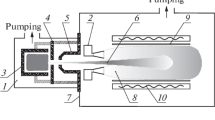Abstract
The results of investigations into the processes occurring in the course of the synthesis, the physicochemical properties, and the compositions of thin borophosphosilicate glass films with phosphorus and boron at a total content up to 30 wt % are generalized. The films are prepared using four chemical vapor deposition methods at deposition temperatures ranging from 380 to 520°C, followed by heat treatment at temperatures of 700–950°C. It is demonstrated that the substantial differences in the properties of the glass films studied can be explained by two factors. The first factor is associated with the porosity of glass films and the occurrence of boron atoms in the threefold coordination with respect to oxygen in the glass. The second factor involves the total content of phosphorus and boron oxides, the concentration of phosphorus oxide clusters embedded into the glass structure, and their sizes. A novel approach is proposed for the characterization of the chemical stability of thin glass films used in the technology of silicon integrated circuits.
Similar content being viewed by others
REFERENCES
Vapor Deposition, Powell, C.W., Oxley, J.H, and Blocher, J.M., Eds., New York: Wiley, 1968. Translated under the title Osazhdenie iz gazovoi fazy, Moscow: Atomizdat, 1970.
Razuvaev, G.A., Gribov, B.G., Domrachev, G.A., and Solomatin, B.A., Metalloorganicheskie soedineniya v elektronike (Organometallic Compounds in Electronics), Moscow: Nauka, 1972, pp. 172–176.
Tauber, R., Chemical Vapor Deposition of Amorphous and Polycrystalline Thin Films, in Silicon Processing for VLSI Era, Wolf, S., Ed., Sunset Beach: Lattice, 1986, vol. 1, pp. 161–197.
Adams, A.C., Deposition of Dielectric Films and Polycrystalline Silicon, in VLSI Technology, Sze, S.M., Ed., New York: McGraw-Hill, 1983. Translated under the title Tekhnologiya SBIS, Moscow: Mir, 1986.
Dukhanova, T.G., Vasilev, V.Yu., and Veretenin, Yu.I., Preparation, Properties, and Application of Borophosphosilicate Glass Films in Integrated Circuit Technology, Obzory Elektron. Tekh., Ser. 3, Moscow: TsNII "Elektronika," 1988, issue 4, pp. 1–72.
Vassiliev, V.Y., Modern BPSG Film Technology, in Visual Booklet of Short Courses at IV International Dielectric for ULSI Multilevel Interconnection Conference, Santa Clara (USA), 1998, pp. 111–192.
Vasilev, V.Yu. and Dukhanova, T.G., Vapor Phase Deposition and Properties of Borophosphosilicate Glass Films, Khim. Fiz., 1992, vol. 11, no. 12, pp. 1699–1710.
Vasilev, V.Yu., Regularities of the Growth of Borophosphosilicate Glass Films upon Chemical Vapor Deposition, Zh. Fiz. Khim., 1999, vol. 73, no. 7, pp. 1191–1198.
Vasilev, V.Yu., Interrelation between the Properties of Borophosphosilicate Glass Films and the Growth Conditions upon Chemical Vapor Deposition, Zh. Fiz. Khim., 1999, vol. 73, no. 8, pp. 1351–1356.
Vasilev, V.Yu., Properties of Vapor-Deposited Borophosphorosilicate Glass Layers Employed in Technology of Silicon Integrated Circuits, Fiz. Khim. Stekla, 2000, vol. 26, no. 1, pp. 116–129 [Glass Phys. Chem. (Engl. transl.), 2000, vol. 26, no. 1, pp. 83–92].
Vassiliev, V.Y., Zheng, J.Z., Tang, S.K., Lu, W., Hua, J., and Lin, Y.S., Growth Kinetics and Deposition-Related Properties of Subatmospheric-Pressure Chemically Vapor Deposited Borophosphosilicate Glass Films, J. Electrochem. Soc., 1999, vol. 146, no. 8, pp. 3039–3051.
Vassiliev, V.Y., Evolution of Borophosphosilicate Glass Film Defects, J. Dielectrics ULSI Multilevel Interconnection, 1999, vol. 1, no. 1, pp. 15–28.
Vasilev, V.Yu., On the Nature of Defects and Mechanism of Their Formation in Thin Borophosphosilicate Glass Layers Produced by Vapor Deposition upon Fabrication of Integrated Circuits, Fiz. Khim. Stekla, 2000, vol. 26, no. 1, pp. 130–145 [Glass Phys. Chem. (Engl. transl.), 2000, vol. 26, no. 1, pp. 93–103].
Vasilev, V.Yu. and Sukhov, M.S., Equipment and Technique for Low-Pressure Vapor Deposition of Films: Part1, Obzory Elektron. Tekh., Ser. 7, Moscow: TsNII "Elektronika," 1985, issue 3, pp. 1–46.
Vasilev, V.Yu. and Sukhov, M.S., Equipment and Technique for Low-Pressure Vapor Deposition of Films: Part2, Obzory Elektron. Tekh., Ser. 7, Moscow: TsNII "Elektronika," 1985, issue 4, pp. 1–52.
Lu, W., Vassiliev, V.Y., Zheng, J.Z., and Chan, L., Comparison of Sub-Atmospheric BPSG Films with Plasma Enhanced BPSG Films, Proceedings of III International Dielectric for ULSI Multilevel Interconnection Conference, Santa Clara (USA), 1997, pp. 219–222.
Pliskin, U.A., Kerr, D.R., and Perri, D.A., Thin Vitreous Films, in Physics of Thin Films (Advances in Research and Development), Hass, G. and Thun, R.E., Eds., New York: Academic, 1968, vol. 4. Translated under the title Fizika tonkikh plenok, Moscow: Mir, 1970.
Kolesvova, V.A., Borophosphate Glasses, Fiz. Khim. Stekla, 1981, vol. 7, no. 6, pp. 641–646.
Lipkin, L.A., Real-Time Oxidation Monitoring with a Surface Charge Analyzer, J. Electrochem. Soc., 1993, vol. 140, no. 8, pp. 2328–2332.
Dyer, T.W., Moisture Instability of Borophosphosilicate Glass and the Effects of Thermal Treatment, J. Electrochem. Soc., 1998, vol. 145, no. 11, pp. 3950–3956.
Yoshimaru, M. and Matsuhashi, H., Moisture Resistance of Annealed Borophosphosilicate Glass Films for Very Large Scale Integrated Circuit Applications, J. Electrochem. Soc., 1996, vol. 143, no. 9, pp. 3032–3037.
Kolesova, V.A., Structural Investigation of Oxide Glasses by Vibrational Spectroscopy, Fiz. Khim. Stekla, 1983, vol. 9, no. 3, pp. 257–266.
Boron Compounds, Encyclopedia of Chemical Technology, New York: Wiley, 1992, vol. 4, pp. 360–418.
Wang, C.Y., Vassiliev, V.Y., Tan, K.W., and Sudijono, J.L., Properties of Subatmospheric Pressure Borophosphosilicate Glass Films Annealed at Low Thermal Budget Conditions, Proceedings of VI International Dielectric for ULSI Multilevel Interconnection Conference, Santa Clara (USA), 2000, pp. 244–252.
Author information
Authors and Affiliations
Rights and permissions
About this article
Cite this article
Vasilev, V.Y. Interrelation between the Parameters of Chemical Vapor Deposition, Properties, and Structure of Borophosphosilicate Glass Films Used in the Silicon Integrated Circuit Technology. Glass Physics and Chemistry 29, 461–470 (2003). https://doi.org/10.1023/A:1026386929586
Issue Date:
DOI: https://doi.org/10.1023/A:1026386929586




